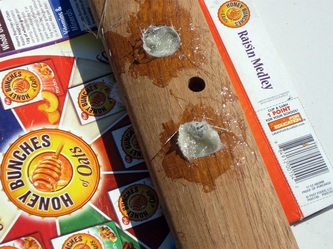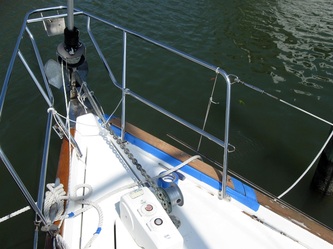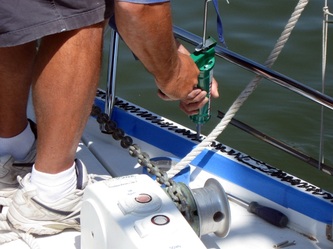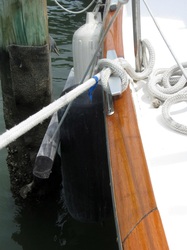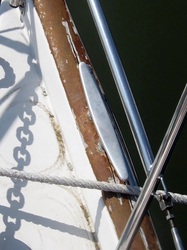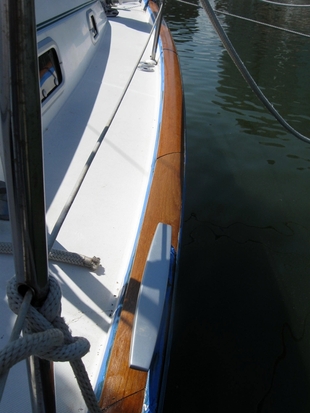
Orion is officially on the market after a couple of weeks cleaning her up and taking care of some cosmetic work to make her look her best. In between boat projects, we got back to swimming and got to visit with the grandkids for a bit as well.
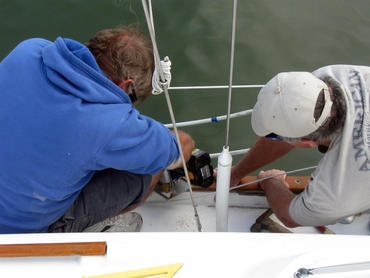
Cleaning up the Caprail
There was only one major project to be done on Orion before we put her on the market. The teak around the forward and mid-cleat on the starboard caprail needed to be replaced since it had split due to the problem with the cleat installation typical of Beneteaus (i.e., an stainless steel cleat in a aluminum sleeve that expands and contracts due to the dissimilar metals in the saltwater environment). While we were considering our options, we discussed the problem with a recent arrival on the dock at Joy’s Marina. Dan had some woodworking skills and offered to do the job for a very good price. So, we just needed to marshal the supplies and the work could begin.
There was only one major project to be done on Orion before we put her on the market. The teak around the forward and mid-cleat on the starboard caprail needed to be replaced since it had split due to the problem with the cleat installation typical of Beneteaus (i.e., an stainless steel cleat in a aluminum sleeve that expands and contracts due to the dissimilar metals in the saltwater environment). While we were considering our options, we discussed the problem with a recent arrival on the dock at Joy’s Marina. Dan had some woodworking skills and offered to do the job for a very good price. So, we just needed to marshal the supplies and the work could begin.
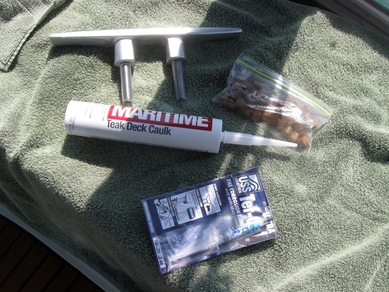
We had already purchased the teak and new cleats from Beneteau last summer. Since the teak has to come from France, which takes about 12 weeks, we wanted to get it in while we were in one place and could arrange for its shipment. The teak comes in sections. We purchased the forward section for the starboard side. We would cut this to fit both the forward cleat and the mid-cleat. The final supplies were more easily acquired: Maritime teak caulk some ½” teak plugs, some Tef-gel and epoxy.
Once the supplies were assembled and the weather cleared, Dan and Dave got to work. First, they removed the old cleat, popped the teak plugs, and removed the screws holding the forward section in place. After making a cut in the teak which would become the new seam, the existing teak was pried off and the fiberglass underneath cleaned of the original caulk. The teak from Beneteau was pre-drilled with holes for the cleat and the screws, which made the bow cleat installation a little easier than the mid-cleat. To prevent the split from recurring, the original metal spacer would be replaced with FRP to prevent the expansion problem. Dave and Dan filled the pre-drilled holes with FRP, which would become the new spacer. Once set, it was sanded and drilled to allow the cleat bolt to move smoothly through.
After a final fitting and adjustments to ensure a smooth transition to the existing wood, Dan applied the caulk to the deck and the seam, then fitted the new board in place. Once the new cleat was installed, the teak plugs were fitted in place, and the repair was complete. The mid-cleat required a little more work, since the teak rail was not cut for that section of the boat. This required more work to cut the board to fit and to ensure the cleat and screw holes lined up.
Once both repairs were complete, Cathy took a day to strip and sand the entire rail, then re-finish with Cetol Natural Teak -- something she’s been wanting to do for several years now. The starboard caprail now shines like the rest of Orion’s brightwork, which now actually earns that description.
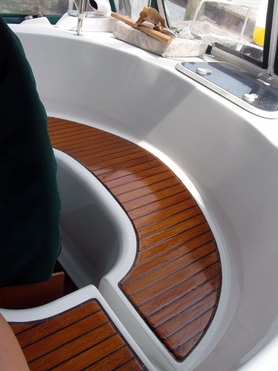
And what about the rest of Orion?
With the caprail repair done, what else was there to do? Nothing major, but a lot of little things that would make the boat show her best.
Fresh Water: Since the fresh water had been winterized, we emptied, refilled it with some bleach added and then emptied and refilled it again. The antifreeze had fouled the PurestOne filter as well, so we replaced it. We now routinely drink the water again.
Head/Holding Tank: We put several gallons of vinegar through the head into the holding tank and let it sit for several days to eat away anything left in the lines and the holding tank. Now the head has no odor at all.
Bimini / Enclosure: With the sewing machine back in Hampton, Cathy took down the bimini and re-stitched all its seams and bindings. She inspected the enclosure panels and re-stitched any that needed it. Finally, she cleaned and polished the strataglass panels.
Coast Guard Safety Inspection: We checked over our safety supplies and prepared for a safety inspection. We realized we had taken Orion's flares to the little boat by mistake, so we bought some more and passed our inspection with flying colors.
On Deck: Cathy stripped the swim platform, the swim ladder stairs and the cockpit drain, which were showing some more wear than the other wood. She re-applied the Cetol to all the wood on deck and it’s looking the best it has in years. She also waxed the deck and polished the stainless steel to add to the shine.
Engine: Having changed oil and filters before leaving in the fall, we just had to run the antifreeze out of the engine and it was ready to go.
Bilge: We checked under the floor boards and cleaned under all of them. The bilge pump in the aft cabin, which had been wired to run continuously when installed, was changed to switch on only when the instruments were on or the manual switch was thrown. This will prevent it from accidentally running down the batteries. The bilge pump in the main saloon had been inadvertently disabled when our friend cleaned out the filter and didn’t secure the cover cleanly. Once back in place the bilge worked fine.
Bottom Cleaning: Our friend Sue cleaned the bottom and replaced the zinc.
Instruments / Electronics: We turned on the instruments and checked out the electronics. Some work done over the winter had jostled a connection loose under the helm that was easily restored.
Deck Washdown: Another problem we discovered was the deck washdown fitting under the sink in the head had broken, presumably due to too much pressure being applied by items stored in the compartment. Dave ordered a new fitting and installed it, but we were grateful we discovered it before we opened the thru-hull for the deck washdown. Whew!
With the boat cleaned up and in shipshape, Dave began placing ads on various internet sites and posting flyers locally. Thanks to his efforts, we’ve already had a few inquiries and have shown the boat once. We’ll see how it goes.
With the caprail repair done, what else was there to do? Nothing major, but a lot of little things that would make the boat show her best.
Fresh Water: Since the fresh water had been winterized, we emptied, refilled it with some bleach added and then emptied and refilled it again. The antifreeze had fouled the PurestOne filter as well, so we replaced it. We now routinely drink the water again.
Head/Holding Tank: We put several gallons of vinegar through the head into the holding tank and let it sit for several days to eat away anything left in the lines and the holding tank. Now the head has no odor at all.
Bimini / Enclosure: With the sewing machine back in Hampton, Cathy took down the bimini and re-stitched all its seams and bindings. She inspected the enclosure panels and re-stitched any that needed it. Finally, she cleaned and polished the strataglass panels.
Coast Guard Safety Inspection: We checked over our safety supplies and prepared for a safety inspection. We realized we had taken Orion's flares to the little boat by mistake, so we bought some more and passed our inspection with flying colors.
On Deck: Cathy stripped the swim platform, the swim ladder stairs and the cockpit drain, which were showing some more wear than the other wood. She re-applied the Cetol to all the wood on deck and it’s looking the best it has in years. She also waxed the deck and polished the stainless steel to add to the shine.
Engine: Having changed oil and filters before leaving in the fall, we just had to run the antifreeze out of the engine and it was ready to go.
Bilge: We checked under the floor boards and cleaned under all of them. The bilge pump in the aft cabin, which had been wired to run continuously when installed, was changed to switch on only when the instruments were on or the manual switch was thrown. This will prevent it from accidentally running down the batteries. The bilge pump in the main saloon had been inadvertently disabled when our friend cleaned out the filter and didn’t secure the cover cleanly. Once back in place the bilge worked fine.
Bottom Cleaning: Our friend Sue cleaned the bottom and replaced the zinc.
Instruments / Electronics: We turned on the instruments and checked out the electronics. Some work done over the winter had jostled a connection loose under the helm that was easily restored.
Deck Washdown: Another problem we discovered was the deck washdown fitting under the sink in the head had broken, presumably due to too much pressure being applied by items stored in the compartment. Dave ordered a new fitting and installed it, but we were grateful we discovered it before we opened the thru-hull for the deck washdown. Whew!
With the boat cleaned up and in shipshape, Dave began placing ads on various internet sites and posting flyers locally. Thanks to his efforts, we’ve already had a few inquiries and have shown the boat once. We’ll see how it goes.
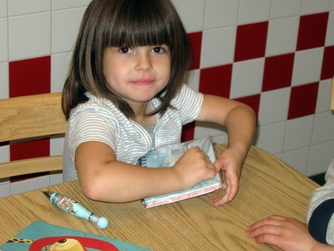
Our granddaughter, Alexis, opens a birthday gift.
So, as we spend our time in Hampton, we're enjoying our friends and family here, as well as those who keep passing through at the Public Piers across the river. Most recently, we saw Patty and Frank on Dream Weaver, who made their first trip to Hampton this year. We showed them the sites and after a few days said goodbye as they headed up the bay. If you're passing through this way, stop into Hampton. We'd love to see you.
